
International Research Journal of Engineering and Technology (IRJET) e-ISSN:2395-0056
Volume: 11 Issue: 09 | Sep 2024 www.irjet.net
p-ISSN:2395-0072


International Research Journal of Engineering and Technology (IRJET) e-ISSN:2395-0056
Volume: 11 Issue: 09 | Sep 2024 www.irjet.net
p-ISSN:2395-0072
Aarya Sutar1, Kedar Mhetre2
1Graduate Student, K.J. Somaiya Institute of Technology, Mumbai, Maharashtra, India
2 Graduate Student, K.J. Somaiya Institute of Technology, Mumbai, Maharashtra, India
Abstract - “HerbVision”: To address the widespread need for knowledge about Ayurvedic medicinal plants, for this HerbVision was developed. This app allows users to swiftly identify plants by uploading or capturing images. The machine learning model categorizes species and provides detailed information on the medicinal properties of each plant. The app seeks to bridge this gap between ancient knowledge and current technology systems by appreciating these deeptraditions.Byleveraging both YOLOv8as well as the Flutter framework, users can effortlessly discover multitudesofIndianherbal plantsandgaininsightsontheir curative values through it. The research not only helps identify medicinal plants but also enables one to have a better understanding of the natural resources that contributetoholistichealthcare.Thispaperpresentsthefull studyconsistingofintroduction,reviewofliterature,system architecture, detailed methodology, case scenarios in realworld, and concluding remarks. It comes from the fact that India has some of the richest traditional herbs used in Ayurvedicmedicineovercenturies.
Key Words: Ayurvedic Medicine, Indian Medicinal Plants, Object Detection, YOLOv8, Flutter Mobile Application, Healthcare Technology.
Medicinal plants represent the cornerstone of traditional medicine systems globally, with India's ancient Ayurvedic tradition particularly renowned for its profound understanding and utilization of plant-based therapies. Despite the pivotal role of medicinal plants in healthcare, many species indigenous to India are underutilized and marginalized in modern medical practice, reflecting a significant gap between traditional wisdom and contemporaryhealthcaretechnology.
HerbVision emerges as a pioneering solution to bridge this divide by harnessing state-of-the-art machine learning technologies, notably the YOLOv8 model and the Flutter mobile app development framework. This innovative integration empowers users to delve into India's rich botanical heritage, facilitating seamless plant identification
and providing comprehensive information on their medicinalproperties.[1]
The research paper elucidates the meticulous development and rigorous validation processes undertaken to ensure HerbVision's accuracy and efficacy as a tool for herbal remedyidentification.[2] Byenablinguserstomakeinformed healthcare decisions grounded in Ayurvedic principles and promoting sustainable plant utilization, HerbVision contributestothepreservationoftraditionalknowledgeand thepromotionofholisticwellbeing.
Additionally, the research endeavors to explore broader implications of blending traditional wisdom with modern technology, unveiling opportunities for environmental stewardship and fostering a deeper connection between individuals and their natural surroundings. In essence, HerbVision stands as a beacon of innovation at the intersection of ancient wisdom and contemporary technology, offering healing pathways that honor the past whileembracingthefuture
Herbal medicine is a vast field that encompasses various disciplines, including the history of using medicinal plants, clinical practice, medical science, and cultural perspectives. Scientistsandresearchersfromaroundtheworldcontribute to this field by sharing their knowledge through books, articles, and personal accounts, offering a comprehensive understandingofherbalmedicine.
In this literature review, we aim to provide an overview of thelatesttechnologiesinherbalresearch.[3]Wewillfocuson advancements in plant identification, the digital storage of knowledge about medicinal plants, and the integration of traditionalknowledgewithmodernscientificapproaches.
There are several academic journalsthat exploretheuse of medicinal plants throughout history and across different regions.Forexample,"Plants:Past,PresentandFuture" and "The Plant Cell" are two journals that delve into this topic.

International Research Journal of Engineering and Technology (IRJET) e-ISSN:2395-0056
Volume: 11 Issue: 09 | Sep 2024 www.irjet.net p-ISSN:2395-0072
These journals, along with others like "Medicinal Plants of India: Compendium of 500 Species" and "Handbook of Medical Botany," [4] contain a wealth of articles that are availablebothinphysicalanddigitalformats.
Digital archivesandlibrariesplaya crucialroleinproviding resources for medicinal plant research. Some notable examples include the Medicinal Plant Digital Library, the National Center for Biotechnology Information (NCBI), the Medicinal Plant Database (MPD),and the Missouri Botanical Garden's Medicinal Use Plant databases. Additionally, the Kew Medicinal Plant Names Service (MPNS), World Health Organization (WHO) Global Atlas of Traditional, Complementary and Alternative Medicine, PubMed Central (PMC), and Traditional Knowledge Digital Library (TKDL) offer valuable information such as plant descriptions, traditionalmedicinaluses,medicinalproducts,andscientific articles. These resources are invaluable for scientists, doctors, and anyone interested in herbal and traditional medicine.
There are already some mobile applications available, such as Plantum, Botan, and MyRemedy, that help users identify plants and learn about their medicinal properties. However, these apps often lack comprehensive information about Indian Ayurvedic medicinal herbs. While they are useful for understanding general plant types and their medicinal properties, they do not specifically focus on the unique properties and therapeutic benefits of Indian Ayurvedic herbs. This highlights the need for a specialized application thatnotonlyhelpsidentifyplantsbutalsoprovidesin-depth knowledgeaboutIndianAyurvedicmedicinalplants.Suchan appwouldfillacriticalgapinthecurrentmarket.
The findings from the research papers foreshadow a fast increasingmovementofagrounddevelopmentofthemobile applications by the different research groups to spot medically potent plants. These types of the apps among many other advanced technologies, include fuzzy logic, neural networks, computer vision, and machine learning, to givetheusersadetailedinformationoftheplantswhichthe take pictures using their phones. Using this tool, identifying plants in digital recognition systems is not only rapid but also reduces any bias the human eye brings to the picture. Furthermore, these apps act as a getaway for the dissemination of important details about medicinal plants increasing its chances of conservation and cultivating informedandsustainableusepractices.Thereby,theadvent of these mobile apps for improving plant knowledge becomes a landmark in narrowing down the credibility gap
between ancestral practices and contemporary technology resulting in profound implications for conserving and managingproperlysuchmedicinalplantresources.
Despite the significant medicinal value of Ayurvedic plants, accurately identifying and classifying these rare and diverse species remains a challenging task. Traditional methods often rely on expert knowledge and manual inspections, which are time-consuming, error-prone, and inaccessible to the general public. This project aims to address these challenges by developing a robust software solution that leverages advanced image processing and machine learning techniques. By utilizing a cross-platform mobile application integrated with TensorFlow Lite for real-time inference, the project seeks to provide a user-friendly, efficient, and scalable tool for identifying Ayurvedic medicinal plants basedontheiruniquemorphologicalfeatures.Thisapproach will not only enhance the accessibility of medicinal plant knowledgebutalsosupportsustainablehealthcarepractices andpreservetraditionalwisdom
The proposed system aims to enhance the identification of Ayurvedicmedicinalplantsthrougharobust,multi-platform software solution. We will develop a cross-platform mobile application using the Flutter framework to ensure compatibility across various devices and operating systems, providingusers witha seamlessexperience.Theapplication will integrate TensorFlow Lite for efficient deployment of machine learning models, enabling real-time plant identification based on morphological features, including leaves, fruits, flowers, and stems. Feature extraction will be performedusingadvancedtechniqueslikeMATLAB’sregion props table to ensure precise analysis of plant images. The system will include a comprehensive database of medicinal plants, offering detailed information on their properties and uses. Additionally, the design will allow for future enhancements, such as incorporating more plant parts and advanced neural network methods, ensuring the system remains adaptable and accurate. This approach bridges traditional knowledge with modern technology, making the identification of Ayurvedic medicinal plants more accessible andefficient
HerbVisionprojectisstructuredtoprovideacomprehensive and user-friendly approach to medicinal plant identification and education. It integrates various components to achieve itsgoalseffectively.

Volume: 11 Issue: 09 | Sep 2024 www.irjet.net p-ISSN:2395-0072
Herbal Remedy Discovery is a core functionality of HerbVision.Usersbeginbycapturingoruploadingimagesof plantsthroughtheapp.Thisfeatureensureseaseofuseand accessibility, allowing users to utilize the app in diverse settings. Once an image is submitted, HerbVision employs advanced machine learning algorithms to analyze the plant. The app identifies the plant and provides detailed information on its medicinal properties. For instance, if a user experiences digestive issues, the app can identify and suggestplantslikealoeveraorpeppermint,alongwiththeir healthbenefits,thusaidinginnaturalremedydiscovery.
KnowledgeEnrichmentHubisdesignedtocatertostudents, enthusiasts, and practitioners interested in herbal medicine. HerbVision offers access to a wealth of information on various medicinal plants, including their properties, uses, and ecological importance. This educational resource supports academic projects and research by providing comprehensivedataonplantssuchasturmericorginger.By making this information readily available, HerbVision helps deepen users' understanding of herbal medicine and promotes a greater appreciation for plant-based health benefits.
Research Tool for Biodiversity Conservation highlights HerbVision's role in scientific research and environmental protection. The app enables researchers to collect and analyze data on medicinal plants, including those that are rare or endangered. This functionality supports the development of evidence-based conservation strategies and helps maintain ecosystem health. HerbVision facilitates detailed documentation and analysis, contributing to efforts in protecting plant diversity. Additionally, it encourages collaboration among researchers, conservationists, and other stakeholders to implement effective conservation measures.
Community Engagement and Sustainable Healthcare are crucial aspects of HerbVision’s impact on public health and education. Healthcare professionals can use the app for educational outreach, including interactive sessions, seminars, and presentations. The real-time plant identificationfeatureofHerbVisionservesasavaluabletool for teaching communities about the importance of plant conservation and identification. Moreover, the app fosters community involvement by enabling users to participate in documenting and preserving medicinal plants, thereby promoting sustainable healthcare practices and enhancing environmentalstewardship.
Additional Considerations include ongoing evaluation and refinement of HerbVision’s features based on user feedback andtechnologicaladvancements.Regularupdatestotheapp will incorporate new plant data, enhance machine learning
models, and improve user experience. This iterative process ensures that HerbVision remains a cutting-edge tool for plant identification and education, adapting to evolving needs and contributing to the broader field of herbal medicineandconservation.

The flowchart depicts a typical machine learning system where preprocessed data is inputted for pattern recognition. The system learns from this data, typically related to food or environmental factors, to make predictions.Aftertestingandcontinuouslearning,themodelisdeployedfor real-worldapplications,allowinguserstoexperienceitsoutputs
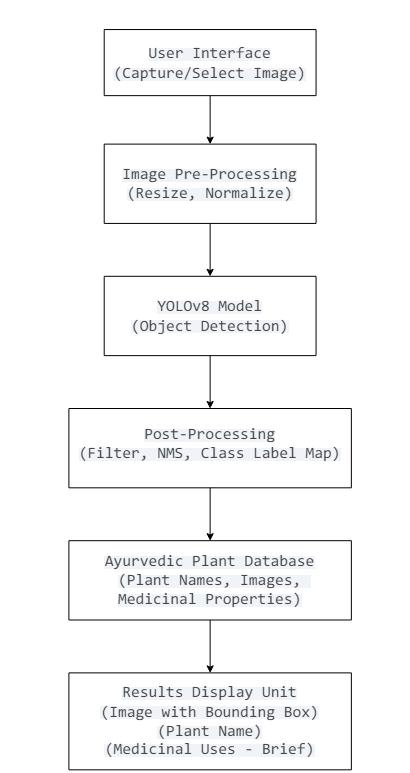
Fig.2.SystemArchitectureDiagram
The system utilizes object detection technology to evaluate images of Ayurvedic plants, comparing them to a database foridentification.Ifamatchisfound,thesystemdisplaysthe plant'snameanditsuses International Research Journal of Engineering and Technology (IRJET) e-ISSN:2395-0056

International Research Journal of Engineering and Technology (IRJET) e-ISSN:2395-0056
Volume: 11 Issue: 09 | Sep 2024 www.irjet.net p-ISSN:2395-0072
The purpose of HerbVision system is to comprise a system foressentialplantidentificationandlearningaboutthesame by using the latest technology and user-ready features for delivery of seamlessly integrated interface.The Tech Stack andFeaturesofHerbVisininclude:
HerbVision is designed to work on both Android andiOS platformsusingthe FLUTTER framework becauseit allowsdeveloperstodevelopasinglecodebaseandsupport them by running on two different platforms concurrently.[5] Fast app development and iteration features of Flutter hot reload guarantee smooth development processes and great performancefeatures.[6]
The mission of HerbVision is based on machine learning modelsforatechniqueofplantidentification.YOLOv8[7] isan objectdetectionmodelthatisusedforreal-timedetectionof themedicinalplantswhosepicturesarecapturedbytheuser themselves or uploaded. This model is investigated on a number of Indian medicinal plants which helps prevent misguided identification or expecting an inappropriate outcome in subsequent applications. Via continuous data collection and a quite stable standard development, HerbVisionoffersacoupleofchoicesthatnotonlyguarantee the authenticity and the whole process, but also make it possible.[8]
The HerbVision app offers a range of features and functions that are aimed at providing users with a personalized experience while promoting research and education on herbs.Uploaded photos of echo and herbs immediate visual(eye-to-eye) recognition will be made possible by the HerbVision YOLOv8 model. The specific information concerning the plants selected that was included in the databaseregardingtheirmedicalproperties,traditionaluses, andtaxonomywasaccessibletothereader.
Apart by that, users are endowed our utilities to be able to ownanaccount,loginandaccessthepersonalfeaturessuch assavingfacilities,userpreferencesandrelations.Withthat, weimplementforums,userfeedbackandplantidentification and integration with which we facilitate the active participation of users and also enable them to contribute to theintegrationofmedicinalplants.
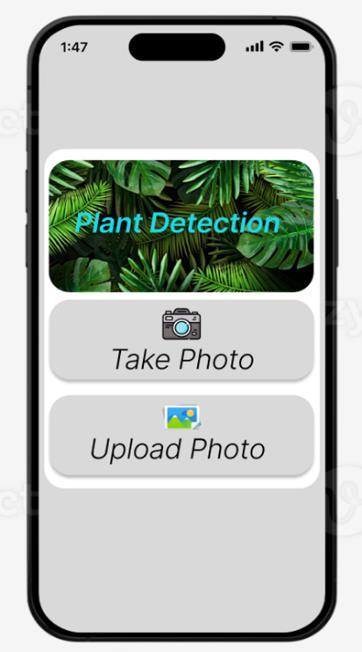
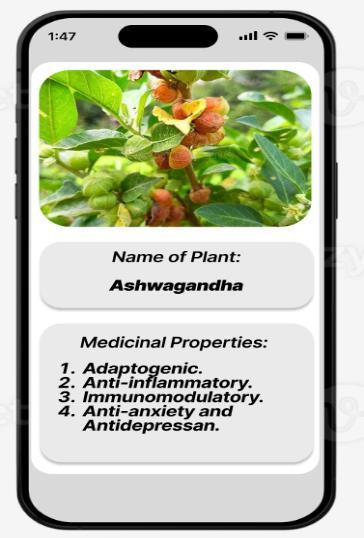
Fig. Home Page Fig. Learn Page
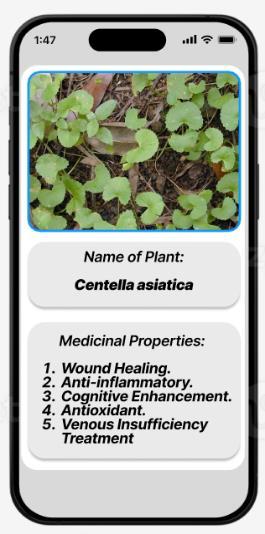
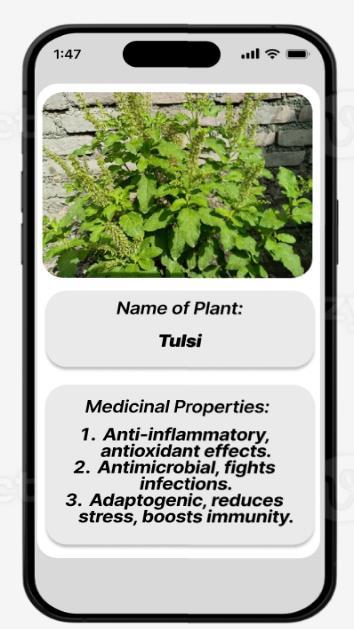
Learn Page
The HerbVision program represents the integration of the intersection of herbal medicine and modern technology, revealing the potential for new solutions to care for today's health and prevention challenges. With the development of the HerbVision mobile app, we have seen how the combination of ancient herbs with machine learning algorithms and a mobile app development framework has becomeapowerfultoolforgreendrugdiscovery,education, researchandcommunityengagement.

International Research Journal of Engineering and Technology (IRJET) e-ISSN:2395-0056
Volume: 11 Issue: 09 | Sep 2024 www.irjet.net p-ISSN:2395-0072
HerbVision's impact extends far beyond its role as an analyticaltool.Itembodiesacommitmenttopreservingand disseminating traditional medical knowledge while embracing the opportunities offered by digital innovation. HerbVision allows users to explore the rich inventory of Indian medicinal plants and learn about their medicinal properties,encouraging adeeperunderstandingofthenaturalresourcesthatleadto health. Additionally, the app serves as a community engagement role by encouraging discussion and collaboration between doctors, healthcare professionals, researchers,andlocalcommunities.
LookingbackonthejourneyoftheHerbVisionprogram,it is clear that our efforts have not only advanced the field of plantidentificationbutalsocontributedtotheoveralldebate about health and biodiversity conservation. By liberating herbal knowledge and promoting the sustainable use of medicinal plants, HerbVision has the potential to empower people to make informed choices for their own health, as well as promote deep social connection with the natural world.
[1] Y. Herdiyeni and N. K. S. Wahyuni, "Mobile application for Indonesian medicinal plants identification using Fuzzy Local Binary Pattern and Fuzzy Color Histogram,"2012InternationalConferenceonAdvanced Computer Science and Information Systems (ICACSIS), Depok,WestJava,Indonesia,2012,pp.301-306.
[2] L.Gaoand X.Lin, "Astudy ontheautomaticrecognition system of medicinal plants,"2012 2nd International Conference on Consumer Electronics, Communications and Networks (CECNet), Yichang, China, 2012, pp. 101103,doi:10.1109/CECNet.2012.6201425.
[3] Uma, K., Sathya Bama, B., Sabarinathan, D., & Mansoor Roomi, S. M. (2022). Identification and retrieval of medicinal plants of Southern India using EfficientB4Net.Journal of Intelligent & Fuzzy Systems,42(6), 5097–5112. https://doiorg.library.somaiya.edu/10.3233/JIFS-211426.
[4] Akinloye Gurnah.Handbook of Medicinal Plants. Astral International Pvt Ltd; 2018. Accessed April 24, 2024. https://search-ebscohostcom.library.somaiya.edu/login.aspx?direct=true&AuthT ype=cookie,ip,uid,url&db=e000xww&AN=2631749&site =eds-live.
[5] Simone Alessandria, Flutter Cookbook: 100+ step-bystep recipes for building cross-platform, professionalgrade apps with Flutter 3.10.x and Dart 3.x , Packt Publishing,2023.
[6] ThomasBailey;AlessandroBiessek;TrevorWills,Flutter for Beginners: An introductory guide to building crossplatform mobile applications with Flutter 2.5 and Dart , PacktPublishing,2021.
[7] S. A. A. Qadri, N. -F. Huang, T. M. Wani and S. A. Bhat, "Plant Disease Detection and Segmentation using Endto-EndYOLOv8:AComprehensiveApproach,"2023IEEE 13th International Conference on Control System, ComputingandEngineering (ICCSCE),Penang,Malaysia, 2023, pp. 155-160, doi: 10.1109/ICCSCE58721.2023.10237169.
[8] Liu S, Zhang J, Song R, Teoh TT. ADA-YOLO: Dynamic FusionofYOLOv8andAdaptiveHeadsforPreciseImage Detection and Diagnosis. 2023.AccessedApril 24,2024. https://search-ebscohostcom.library.somaiya.edu/login.aspx?direct=true&AuthT ype=cookie,ip,uid,url&db=edsarx&AN=edsarx.2312.100 99&site=eds-live.


AaryaSutar GraduateStudent Computer Engineering Department
K. Somaiya Institute of Technology
KedarMhetre GraduateStudent Computer Engineering Department
KJ Somaiya Institute of Technology